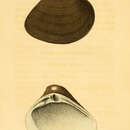Alien species
provided by World Register of Marine Species
De Amerikaanse strandschelp Rangia cuneata komt oorspronkelijk uit de Golf van Mexico. Van daaruit koloniseerde deze tweekleppige de Atlantische kust van Noord-Amerika en Europa. De eerste Europese melding vond plaats in augustus 2005 in de haven van Antwerpen. Introductie gebeurde hoogstwaarschijnlijk door transport van larven in het ballastwater van schepen. Deze soort leeft vooral in estuaria, in brak en zoetwater. In havens kan de Amerikaanse strandschelp voor overlast zorgen door zich te vestigen in industriële koelwatersystemen, waar het de optimale waterstroom kan blokkeren.
- license
- cc-by-4.0
- copyright
- WoRMS Editorial Board
Alien species
provided by World Register of Marine Species
The Atlantic Rangia or wedge clam Rangia cuneata originates from the Gulf of Mexico. From there this bivalve colonized the Atlantic coast of North-America and Europe. The species was first reported in Europe in August 2005 in the Harbour of Antwerp. Introduction most likely happened through transport of larvae in ballast water of ships. The species mainly live in estuaries, brackish and freshwater. In ports, the Atlantic Rangia can become a pest as it establishes itself in industrial cooling pipes where it can obstruct optimal water flow.
VLIZ Alien Species Consortium. (2010).
- license
- cc-by-4.0
- copyright
- WoRMS Editorial Board
Distribution
provided by World Register of Marine Species
Distribution of the subprovince extends northward of Carolinian, Cape Hatteras through Florida
North-West Atlantic Ocean species (NWARMS)
- license
- cc-by-4.0
- copyright
- WoRMS Editorial Board

